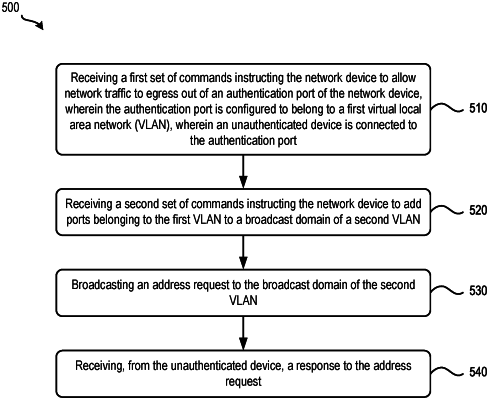| CPC H04L 63/0876 (2013.01) [H04L 12/4679 (2013.01); H04L 61/103 (2013.01); H04L 2101/622 (2022.05)] | 16 Claims |

|
1. A method for authenticating an unauthenticated passive device to receive network traffic, executable by a first network device, comprising:
receiving a first set of commands instructing the first network device to allow network traffic to egress out of an authentication port of the first network device, wherein the authentication port is configured to belong to a first virtual local area network (VLAN), wherein the unauthenticated passive device is connected to the authentication port;
receiving a second set of commands instructing the first network device to add at least one port belonging to the first VLAN to a broadcast domain of a second VLAN;
receiving, from a client device, a request destined for the unauthenticated passive device;
generating the address request;
in response to receiving the request, determining that a first storage of the first network device does not include a mapping comprising an address associated with the unauthenticated passive device,
wherein the address request is generated in response to determining that the first storage of the first network device does not include the mapping comprising the address associated with the unauthenticated passive device;
broadcasting an address request to a plurality of ports within the broadcast domain of the second VLAN;
wherein the address request is broadcasted to the plurality of ports within the broadcast domain of the second VLAN in response to generating the address request; and
receiving, from the unauthenticated passive device, a response to the address request to configure the authentication port to allow ingress and egress traffic to the second VLAN.
|